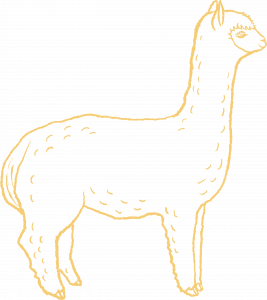
If you provide care for camelids (In this resource camelid(s) is referring only llamas and alpacas) at your sanctuary, having a good understanding of their body language is vital to a successful relationship and care practices. While camelids have different vocalizations that communicate important information, their body language can provide vital insight into their emotional states and health if you are able to interpret them properly. This resource is part of a series on camelid body language and provides a brief introduction to the different ways camelids communicate with their tails. Check out Part 1 where we discuss ear positions! Through this series, you will learn to identify different meanings behind ear/head/tail/body positions, and how context and the combination of these body positions can provide a fuller picture of what is being expressed. Let’s take a general look at body language before taking a closer look at tail positions!
Body Language
Body language can help you better understand your resident’s wishes and emotional, mental, and physical states. Understanding a resident’s body language can allow you to catch early signs of illness, or recognize social issues among the herd that may be negatively affecting them. Body language also tells you a lot about a resident’s comfort level around different individuals and during different situations. This allows caregivers to tailor these situations and their own behaviors to better meet the needs of the individual better. As mentioned above, in camelids, there are a number of elements to pay close attention to: the ears, the head, the neck, the tail, and the overall body position. While each of these areas can provide information about an individual, the whole of them read together will provide the best overall interpretation. But what do you look for in terms of tail position, and what might it mean? Let’s take a closer look!

Tail Positioning In Camelids
You can tell a lot from looking at a camelid’s tail! If you care for camelid residents, you know their tails are fairly short in relation to their body size, covered in hair, and are able to move both back and forth and up and down. You might have seen their tails in a number of different positions, maybe even “wagging” back and forth. But what do those positions and movements mean?
Abnormal Tail Conformation
Some camelids may be born with congenital defects that cause the tail to be crooked or kinked. Others may have sustained an injury that changed the conformation of their tail, which may cause abnormal movement. Their tails may not stand the same as a typical camelid’s tail, and thus care must be taken to learn what movement their tails are capable of and what their position may mean for that individual. Additionally, a tail may be paralyzed or nonexistent if an injury was so severe then an individual lost their tail. Obviously, these cases will require specialized knowledge of the individual in order to understand what they may be “saying” through body language. Understanding camelid tail placement can also help you detect new injuries or illnesses and treat them immediately. Applying a general concept of camelid communication through tail placement may not be effective in this situation and could lead to misunderstandings and an unhappy resident. Remember, all residents are individuals, and while learning their species-specific behaviors is vital, so is learning about the individual.
While the full meaning of tail positioning comes within the context and understanding other body languages in camelids, there are some basic positions to know. You will see a bit later how the combination of tail and ear/head/body position can provide a fuller picture of what their body language is “saying”!
Generally speaking, the higher the tail, the higher the level of concern/displeasure. However, if a camelid is trying to placate or communicate submissiveness to another camelid, their tail will curl up over onto their back and they will crouch their front legs and lower their neck and head, laying their ears back somewhat. A curved tail may also indicate uncertainty.
Everyone Is An Individual
We mention this frequently because it’s so important! While there are some general things to watch for in terms of body language, it is important to remember that every resident is an individual and what is normal for them may vary somewhat from the general “normal”. Camelids will have various types of hair and fluffiness levels so observing each resident and how they express themselves and what that looks like will help you better understand them.
Neutral/Relaxed
In a neutral or relaxed state, a camelid’s tail will generally be laying flat against their body, without any apparent tension. Some individuals may have tails that have a natural slight arch to them even in their neutral position.

Curious/Alert
If a camelid is mildly curious, you may see their ears turn forward, but their tail may remain in a relaxed position. If they are more alert than casually curious, their tails may lift away from their bodies, arching, but not horizontal or straight up. You might notice this when a resident sees someone coming into sight, hears a noise, or is otherwise alert or curious about a change in their environment.


Alarmed
If a camelid becomes alarmed by something or someone in their environment, their tail will generally rise even higher, arching in line with the body or higher. Their ears will be cocked forward.

Displeasure
If a camelid resident is uncomfortable, feels threatened by some element of a situation, or wants to warn someone away, their tail will generally stick straight out horizontally. Their ears will often also be laid back.

Defensive Behavior
If a resident’s displeasure/discomfort grows and they feel the need to defend themselves, their head will face up, their ears will be pinned back, and their tail will be slightly lifted. This posture is indicative of forthcoming defensive behavior that generally includes spitting.
Serious Displeasure/Confrontational
If a resident feels particularly displeased and feels the need to confront someone, their tail will be high, straight up, or will be curled over their back slightly (though curling over the back is also a sign of submission between camelids, and in that case will be accompanied by a lowered head and neck and ears laid back). All of the above positions should be taken seriously, and steps should be taken to lower any discomfort or anxiety. In conjunction with pinned ears and a head held up, this tail position is a grave warning that they are especially displeased, and whatever is happening to make them feel threatened or uncomfortable should stop immediately before they take offensive (kicking, biting, or charging) measures in an attempt to stop whatever it is that is upsetting them.
Once offensive measures are being taken, you may see a camelid chasing or charging who has their tail high and the ears cocked forward or pinned back.
Flehmen Response
There may be a time you see a camelid resident with their neck lowered, but with their head back and up, and their ears may be laid back, but their tail held in a neutral position. This is not a sign of displeasure or something to be concerned about. This is the flehmen response, where certain species are using their vomeronasal organ in response to certain scents. This is often in response to the scent of urine and helps them determine the reproductive status of their herdmates, though you may see this response to other scents as well.

Questioning/Uncertainty/Submissive
An individual’s tail may flip all the way up and over, laying against their back when signaling their submissive status to a dominant herd member, or when crias approach their mothers to nurse. It may also be observed when an individual is uncertain- they may be seen to approach someone or something with their tail flipped, and slowly lower it as they become more certain or as the question in their mind is answered, so to speak.

Urination/Defecation
A camelid resident’s tail also moves when they are visiting the communal dung pile. Camelids will squat somewhat and move their tails up and out of the way when urinating and defecating. This is normal and doesn’t indicate alarm or displeasure. Maybe just a little need for privacy!

Tail Movement
We have talked about tail positions, but why is their tail swishing or wagging back and forth? Sometimes a tail’s swish is just to discourage flies. Their tails may also wag when excited or displeased. As with all of the above, context is key. What is happening around them, and what is the rest of their body saying? If you notice an abnormal amount of wagging or twitching, it may be time to take a closer look and determine if there is a health issue that needs to be addressed.
The Full Picture
In order to get the full picture of what a camelid resident is trying to “say”, it is important to understand the context of the situation you are witnessing, as well as how the tail, ear, and head are positioned (and the overall body posture). While the above is a good introduction to camelid tail language and can certainly help you have a better idea of what your camelid residents may be experiencing or expressing, you will learn through this series on body language that nuance can be important, and knowing about ear, tail, AND head position will allow you to have a clearer picture of that is being “said”. For now, observe your camelid residents and see what their tails are telling you!

SOURCES:
Exotic Animal Care And Management | Google Books
Recommended Practices In Caring For Llamas & Alpacas | Ohio State University
Alpaca And Camelid Behavior | Kush Veterinary Clinic
Medicine And Surgery Of Camelids | Murray Fowler, Google Books
Those TAILS Can Tell TALES… | Cathy Spalding Gentle Spirit Behavior And Training
Human Ability To Interpret Alpaca Body Language | Journal Of Veterinary Behavior
Behavioral Clues For Detection Of Illness In Wild Animals: Models In Camelids And Elephants








